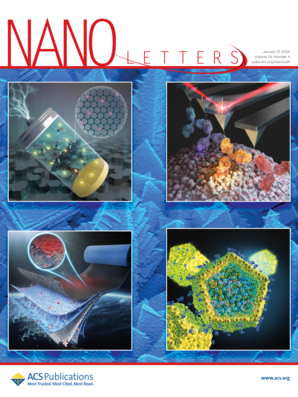Bi1-xSbx中自旋霍尔电导率作为体边界对应的实验测试
IF 9.6
1区 材料科学
Q1 CHEMISTRY, MULTIDISCIPLINARY
引用次数: 0
摘要
体边界对应是拓扑量子材料的电子能带结构和物理行为的基本原理,已经在涉及守恒电荷电流的拓扑系统中进行了严格的测试。然而,对于非守恒自旋电流,体边界对应是否应该成立仍不清楚。我们通过使用自旋转矩铁磁共振来精确探测典型拓扑绝缘体Bi1-xSbx外延薄膜中的电荷-自旋转换效率来解决这个尚未解决的问题。我们发现测量的有效自旋霍尔电导率(SHC)与体带本征SHC的紧密结合计算结果吻合得很好。这些结果表明,远低于费米能量的体态的强自旋轨道纠缠与与金属铁磁体界面的外延Bi1-xSbx薄膜表面态的SHC直接相关。理论和实验之间的完美一致肯定了完全关注体特性的分析的一般价值,即使对于非保守的拓扑自旋电流也是如此。本文章由计算机程序翻译,如有差异,请以英文原文为准。

Spin Hall Conductivity in Bi1–xSbx as an Experimental Test of Bulk-Boundary Correspondence
Bulk-boundary correspondence, a foundational principle underlying the electronic band structure and physical behavior of topological quantum materials, has been rigorously tested in topological systems that involve conserved charge currents. However, it remains unclear whether bulk-boundary correspondence should hold for nonconserved spin currents. We address this unresolved question by using spin-torque ferromagnetic resonance to accurately probe the charge-to-spin conversion efficiency in epitaxial thin films of a canonical topological insulator, Bi1–xSbx. We find that the measured effective spin Hall conductivity (SHC) agrees well with tight-binding calculations for the intrinsic SHC of the bulk bands. These results indicate that the strong spin–orbit entanglement of bulk states well below the Fermi energy connects directly to the SHC of surface states in epitaxial Bi1–xSbx films interfaced with a metallic ferromagnet. The excellent agreement between theory and experiment affirms the generic value of analyses focused entirely on bulk properties, even for nonconserved topological spin currents.
求助全文
通过发布文献求助,成功后即可免费获取论文全文。
去求助
来源期刊

Nano Letters
工程技术-材料科学:综合
CiteScore
16.80
自引率
2.80%
发文量
1182
审稿时长
1.4 months
期刊介绍:
Nano Letters serves as a dynamic platform for promptly disseminating original results in fundamental, applied, and emerging research across all facets of nanoscience and nanotechnology. A pivotal criterion for inclusion within Nano Letters is the convergence of at least two different areas or disciplines, ensuring a rich interdisciplinary scope. The journal is dedicated to fostering exploration in diverse areas, including:
- Experimental and theoretical findings on physical, chemical, and biological phenomena at the nanoscale
- Synthesis, characterization, and processing of organic, inorganic, polymer, and hybrid nanomaterials through physical, chemical, and biological methodologies
- Modeling and simulation of synthetic, assembly, and interaction processes
- Realization of integrated nanostructures and nano-engineered devices exhibiting advanced performance
- Applications of nanoscale materials in living and environmental systems
Nano Letters is committed to advancing and showcasing groundbreaking research that intersects various domains, fostering innovation and collaboration in the ever-evolving field of nanoscience and nanotechnology.
 求助内容:
求助内容: 应助结果提醒方式:
应助结果提醒方式:


